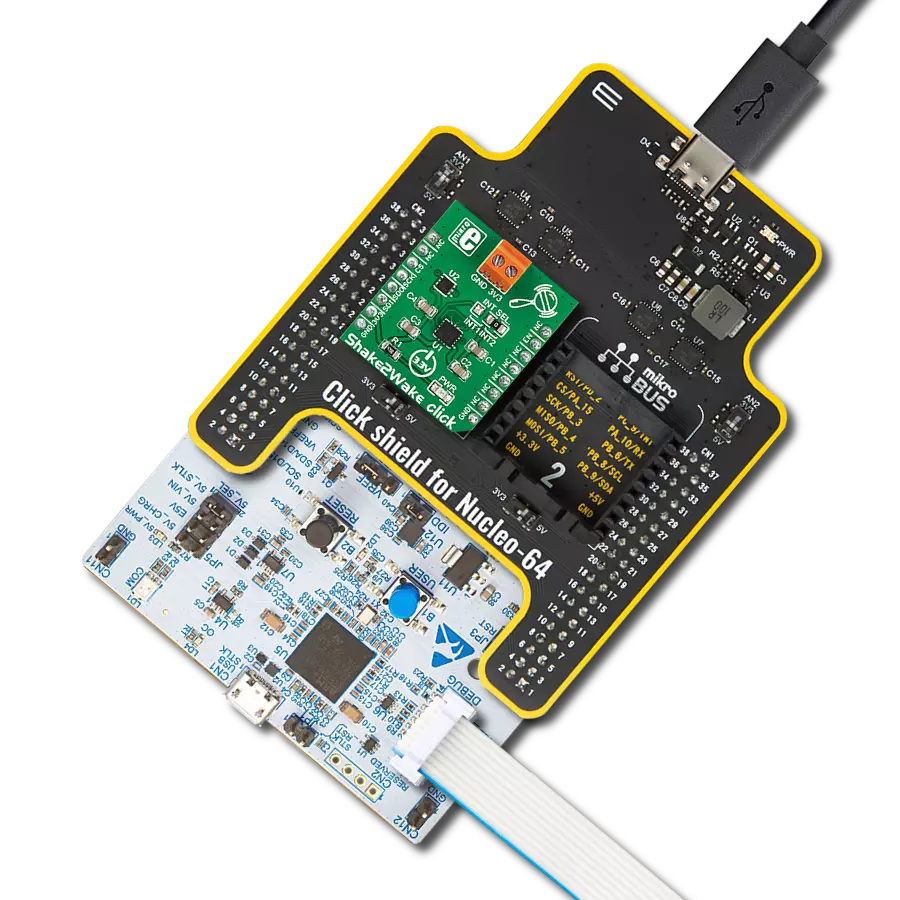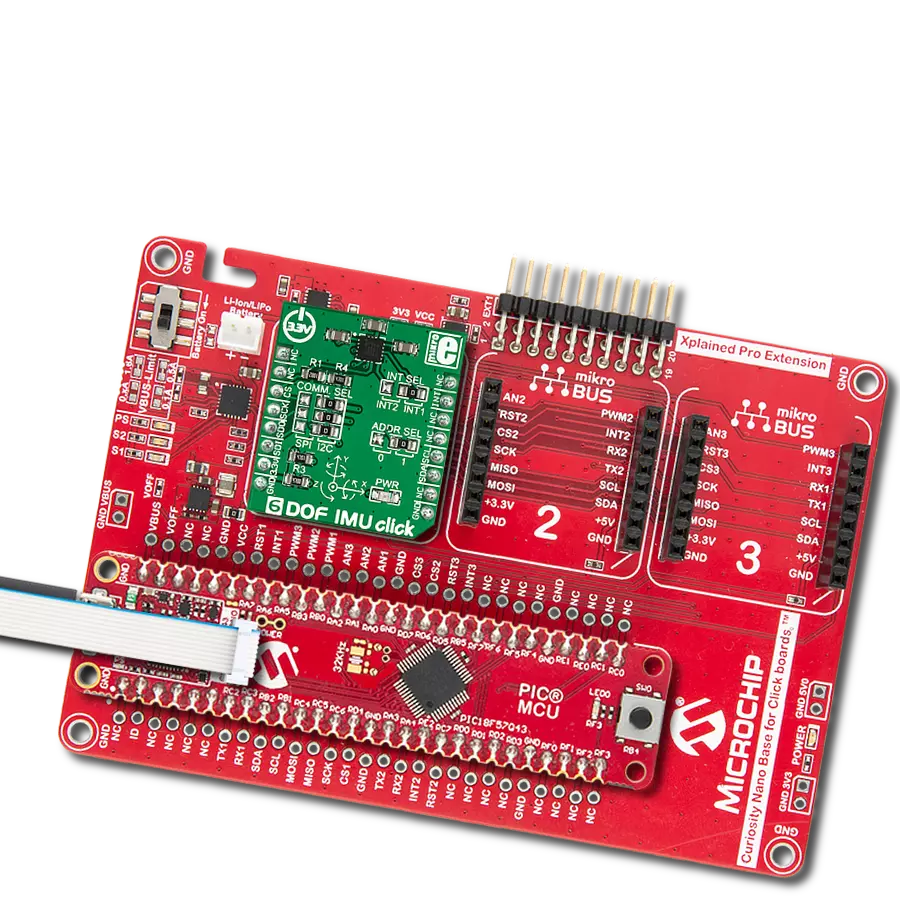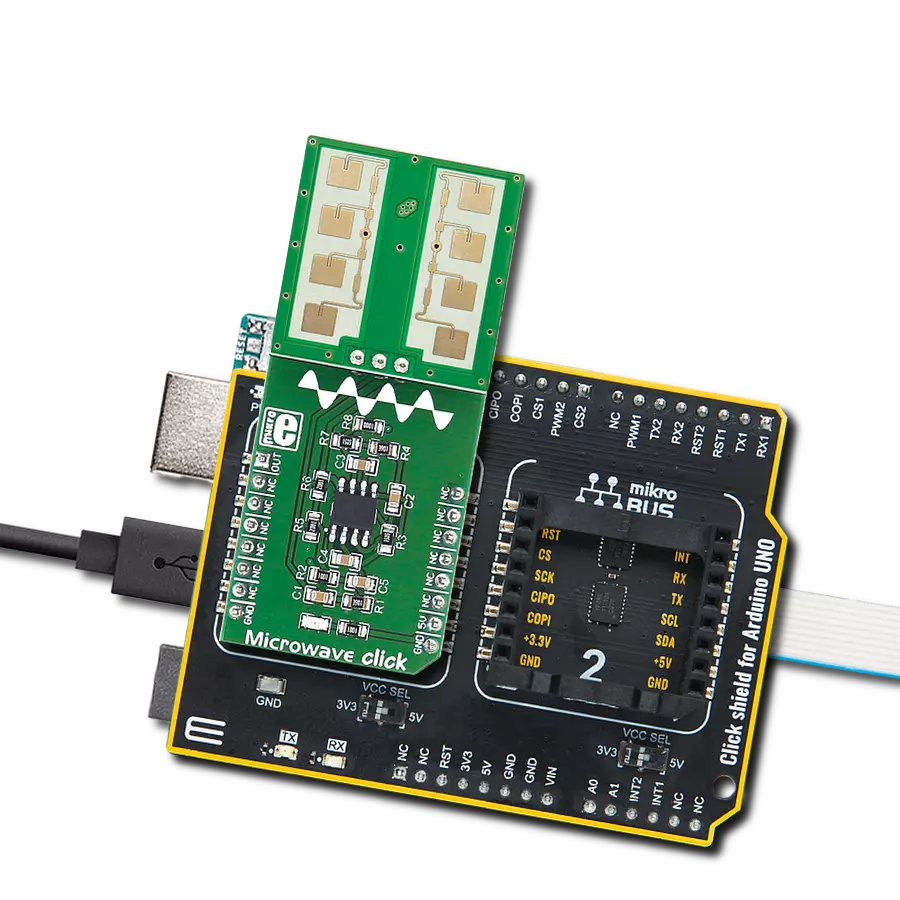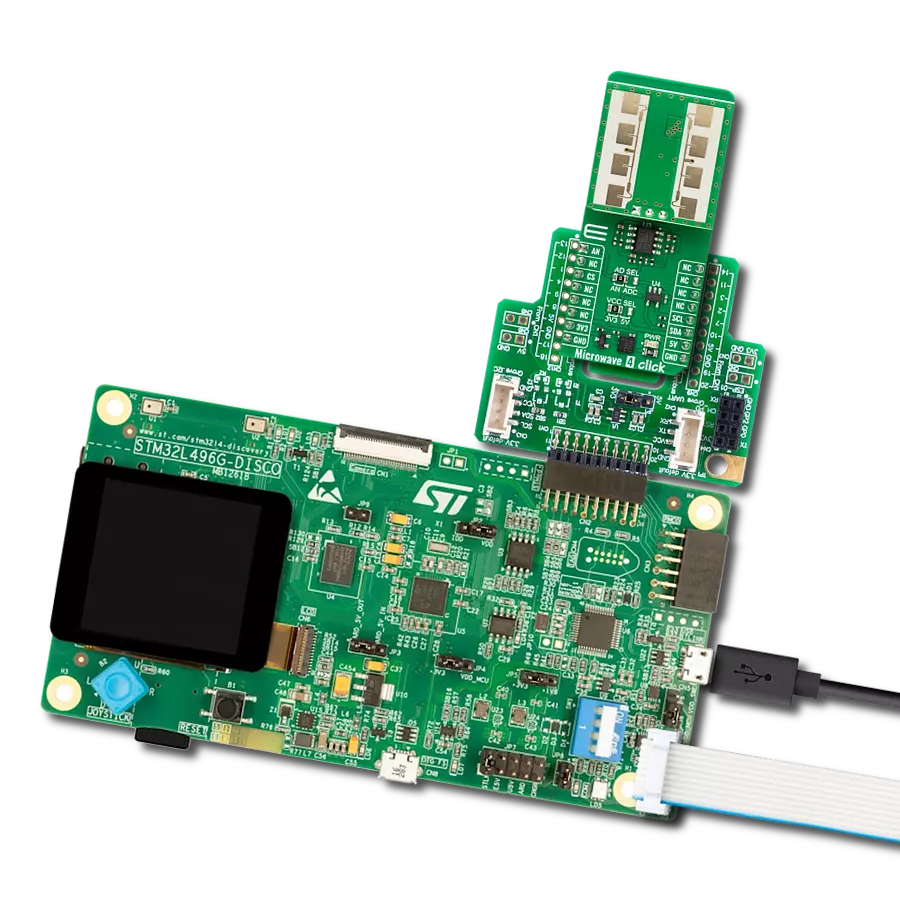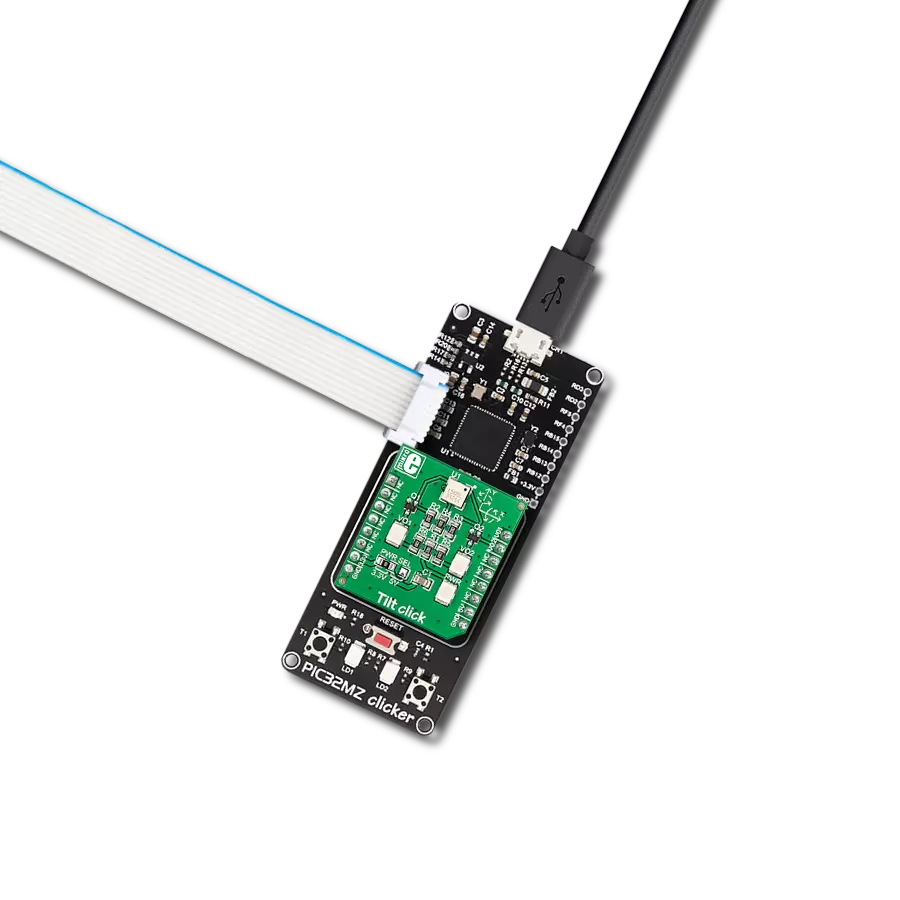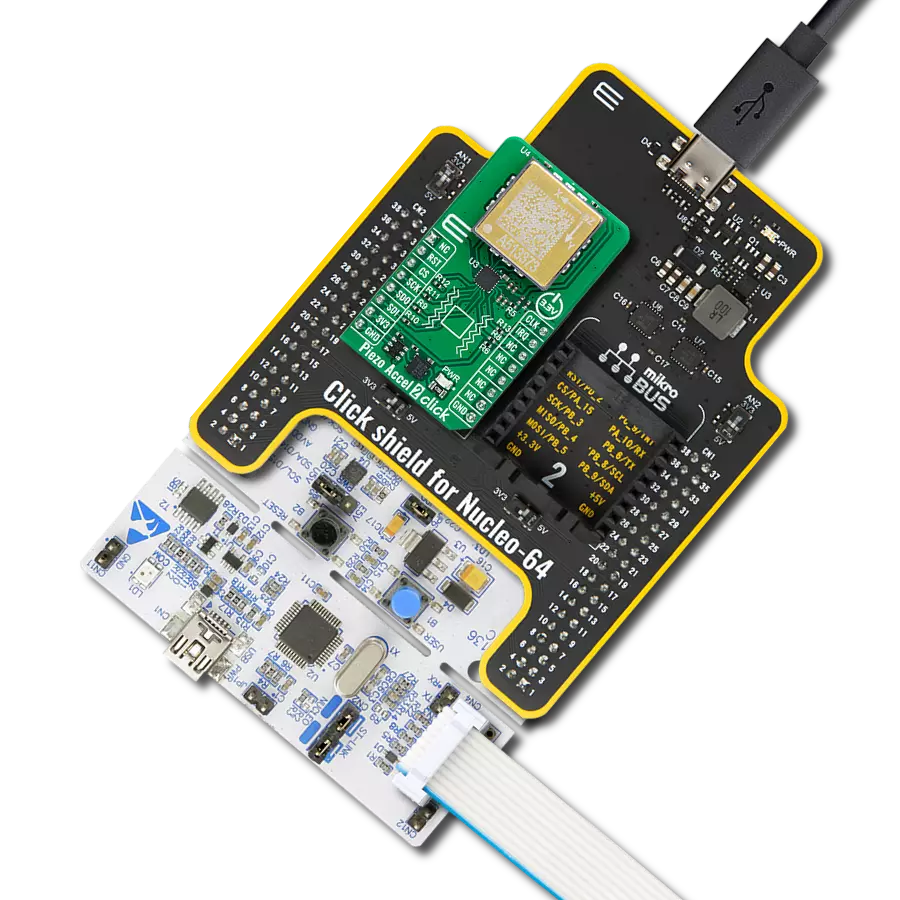Provide high-precision tilt and leveling measurement capabilities for various applications requiring accurate angular orientation sensing
A
A
Hardware Overview
How does it work?
Inclinometer 3 Click is based on the SCL3400-D01, a high-performance, two-axis (XY) inclinometer sensor from Murata, employing their advanced capacitive 3D-MEMS technology for precise tilt sensing. This sensor integrates a sophisticated mixed-signal ASIC that provides signal processing through a flexible SPI digital interface, enhancing its functionality and ease of integration. Housed in a durable 12-pin pre-molded plastic casing, the SCL3400-D01 ensures consistent performance and reliability across its operational lifespan. This sensor is meticulously designed, manufactured, and tested to meet rigorous stability, reliability, and quality standards, making it exceptionally dependable across various temperatures and vibrations. Additionally, it incorporates several
advanced self-diagnostic features that further bolster its operational integrity. Idealfor applications requiring unmatched stability and accuracy in challenging environments, the SCL3400-D01 stands out with its selectable measurement modes of ±30° with a 10Hz Low Pass Filter (LPF) and ±90° with a 40Hz LPF, providing flexible deployment options. It has an ultra-low noise density and a high resolution of up to 32768LSB/g, ensuring precise and clear signal outputs under various conditions. Typical uses of this inclinometer solution include leveling, tilt sensing, structural health monitoring, and more complex applications such as inertial measurement units (IMUs) and positioning and guidance systems, where precise movement and position tracking are crucial. As mentioned, the
Inclinometer 3 Click Click communicates with the host MCU through a standard 4-wire SPI, capable of up to 10MHz operational frequency (2MHz is the typical frequency). Although the SCL3400-D01 is designed to operate only at 3.3V, this Click board™ also includes a TXB0106 logic level translator, which ensures the operation of this Click board™ with both 3.3V and 5V capable MCUs. This Click board™ can operate with either 3.3V or 5V logic voltage levels selected via the VIO SEL jumper. This way, both 3.3V and 5V capable MCUs can use the communication lines properly. Also, this Click board™ comes equipped with a library containing easy-to-use functions and an example code that can be used as a reference for further development.
Features overview
Development board
PIC18F57Q43 Curiosity Nano evaluation kit is a cutting-edge hardware platform designed to evaluate microcontrollers within the PIC18-Q43 family. Central to its design is the inclusion of the powerful PIC18F57Q43 microcontroller (MCU), offering advanced functionalities and robust performance. Key features of this evaluation kit include a yellow user LED and a responsive
mechanical user switch, providing seamless interaction and testing. The provision for a 32.768kHz crystal footprint ensures precision timing capabilities. With an onboard debugger boasting a green power and status LED, programming and debugging become intuitive and efficient. Further enhancing its utility is the Virtual serial port (CDC) and a debug GPIO channel (DGI
GPIO), offering extensive connectivity options. Powered via USB, this kit boasts an adjustable target voltage feature facilitated by the MIC5353 LDO regulator, ensuring stable operation with an output voltage ranging from 1.8V to 5.1V, with a maximum output current of 500mA, subject to ambient temperature and voltage constraints.
Microcontroller Overview
MCU Card / MCU

Architecture
PIC
MCU Memory (KB)
128
Silicon Vendor
Microchip
Pin count
48
RAM (Bytes)
8196
You complete me!
Accessories
Curiosity Nano Base for Click boards is a versatile hardware extension platform created to streamline the integration between Curiosity Nano kits and extension boards, tailored explicitly for the mikroBUS™-standardized Click boards and Xplained Pro extension boards. This innovative base board (shield) offers seamless connectivity and expansion possibilities, simplifying experimentation and development. Key features include USB power compatibility from the Curiosity Nano kit, alongside an alternative external power input option for enhanced flexibility. The onboard Li-Ion/LiPo charger and management circuit ensure smooth operation for battery-powered applications, simplifying usage and management. Moreover, the base incorporates a fixed 3.3V PSU dedicated to target and mikroBUS™ power rails, alongside a fixed 5.0V boost converter catering to 5V power rails of mikroBUS™ sockets, providing stable power delivery for various connected devices.
Used MCU Pins
mikroBUS™ mapper
Take a closer look
Click board™ Schematic

Step by step
Project assembly
Track your results in real time
Application Output
1. Application Output - In Debug mode, the 'Application Output' window enables real-time data monitoring, offering direct insight into execution results. Ensure proper data display by configuring the environment correctly using the provided tutorial.

2. UART Terminal - Use the UART Terminal to monitor data transmission via a USB to UART converter, allowing direct communication between the Click board™ and your development system. Configure the baud rate and other serial settings according to your project's requirements to ensure proper functionality. For step-by-step setup instructions, refer to the provided tutorial.

3. Plot Output - The Plot feature offers a powerful way to visualize real-time sensor data, enabling trend analysis, debugging, and comparison of multiple data points. To set it up correctly, follow the provided tutorial, which includes a step-by-step example of using the Plot feature to display Click board™ readings. To use the Plot feature in your code, use the function: plot(*insert_graph_name*, variable_name);. This is a general format, and it is up to the user to replace 'insert_graph_name' with the actual graph name and 'variable_name' with the parameter to be displayed.

Software Support
Library Description
This library contains API for Inclinometer 3 Click driver.
Key functions:
inclinometer3_get_axes- This function reads the accelerometer sensor axes data by using SPI serial interface.inclinometer3_get_temperature- This function reads the temperature measurement data by using SPI serial interface.
Open Source
Code example
The complete application code and a ready-to-use project are available through the NECTO Studio Package Manager for direct installation in the NECTO Studio. The application code can also be found on the MIKROE GitHub account.
/*!
* @file main.c
* @brief Inclinometer 3 Click example
*
* # Description
* This library contains API for the Inclinometer 3 Click driver.
* The library initializes and defines the SPI drivers to
* write and read data from registers, as well as the default configuration
* for the reading accelerator and temperature data.
*
* The demo application is composed of two sections :
*
* ## Application Init
* The initialization of the SPI module, log UART, and additional pins.
* After the driver init, the app executes a default configuration.
*
* ## Application Task
* This example demonstrates the use of the Inclinometer 3 Click board.
* Measures and displays acceleration data for the XY-axis [mg]
* and temperature [degree Celsius] data.
* Results are being sent to the UART Terminal, where you can track their changes.
*
* @author Nenad Filipovic
*
*/
#include "board.h"
#include "log.h"
#include "inclinometer3.h"
static inclinometer3_t inclinometer3;
static log_t logger;
void application_init ( void )
{
log_cfg_t log_cfg; /**< Logger config object. */
inclinometer3_cfg_t inclinometer3_cfg; /**< Click config object. */
/**
* Logger initialization.
* Default baud rate: 115200
* Default log level: LOG_LEVEL_DEBUG
* @note If USB_UART_RX and USB_UART_TX
* are defined as HAL_PIN_NC, you will
* need to define them manually for log to work.
* See @b LOG_MAP_USB_UART macro definition for detailed explanation.
*/
LOG_MAP_USB_UART( log_cfg );
log_init( &logger, &log_cfg );
log_info( &logger, " Application Init " );
// Click initialization.
inclinometer3_cfg_setup( &inclinometer3_cfg );
INCLINOMETER3_MAP_MIKROBUS( inclinometer3_cfg, MIKROBUS_1 );
if ( SPI_MASTER_ERROR == inclinometer3_init( &inclinometer3, &inclinometer3_cfg ) )
{
log_error( &logger, " Communication init." );
for ( ; ; );
}
if ( INCLINOMETER3_ERROR == inclinometer3_default_cfg ( &inclinometer3 ) )
{
log_error( &logger, " Default configuration." );
for ( ; ; );
}
log_info( &logger, " Application Task " );
log_printf( &logger, " ________________________ \r\n" );
}
void application_task ( void )
{
float temperature = 0, x_axes = 0, y_axes = 0;
if ( ( INCLINOMETER3_OK == inclinometer3_get_temperature( &inclinometer3, &temperature ) ) &&
( INCLINOMETER3_OK == inclinometer3_get_axes( &inclinometer3, &x_axes, &y_axes ) ) )
{
log_printf( &logger, " Accel X: %.2f mg\r\n", x_axes );
log_printf( &logger, " Accel Y: %.2f mg\r\n\r\n", y_axes );
log_printf( &logger, " Temperature : %.2f degC\r\n", temperature );
log_printf( &logger, " ________________________ \r\n" );
Delay_ms ( 1000 );
}
}
int main ( void )
{
/* Do not remove this line or clock might not be set correctly. */
#ifdef PREINIT_SUPPORTED
preinit();
#endif
application_init( );
for ( ; ; )
{
application_task( );
}
return 0;
}
// ------------------------------------------------------------------------ END
Additional Support
Resources
Category:Motion



















